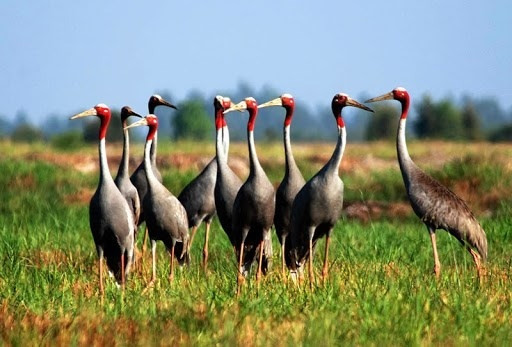

Over the past two years, the red-crowned crane has not returned to the park due to climate change and the changing ecological environment. Dong Thap is working on a conservation project to bring the birds back to Tram Chim.
Huynh Thanh Tuoi, a member of Tram Chim National Park’s specialized protection group, carefully drives his boat into the area where restoration work is being done. With 10‑year working experience in the National Park, Tuoi knows that the cranes will only return to Tram Chim in the dry season to find food.
Red-crowned cranes are usually spotted every year in Tram Chim from December to April. When their favorite food cannot be found, the birds will leave, Tuoi said.
“I used to see a lot of red-crowned cranes every year a few years back. But they have stopped coming here. Water chestnuts, the crane’s preferred food, are available, but the birds have not returned yet,” Tuoi shared.
One of the reasons, according to a report by Tram Chim National Park, is due to the seriously-degraded natural ecological environment, especially the natural wetlands and agricultural production areas.
Tram Chim National Park witnessed hundreds of red-crowned cranes arrive in the winters of the 1980s. They stayed until the spring came. The absence of the birds leaves those working here worried. The Tram Chim National Park staff hopes that one day the cranes will return. Tran Quoc Vuong works at Tram Chim National Park’s International Cooperation Research Department.
“The rare crane is spiritually and culturally sacred. It is the symbol of Tram Chim National Park. Their appearance shows a greater connection of people with nature,” Vuong said.
Dong Thap province launched a project to conserve and develop red‑crowned cranes in Tram Chim National Park in May this year. Its main goal is to raise 150 cranes within ten years starting in 2023. At least 100 of them could survive and grow after being returned to their native habitat.
The US$3.7 million project also aims to improve the crane’s habitat; build an organic agricultural production area around the park; develop a sustainable environment for the birds; and mobilize local communities to participate in protecting them.
Doan Van Nhanh, Deputy Director of the Center for Conservation and International Cooperation at Tram Chim National Park, said that preparations have been completed to welcome the head-crowned cranes to be imported from Thailand at the end of this year.
“The conservation process relies on the ecological needs of the red-crowned cranes. The birds will often leave in May. They may leave sooner or later depending on the weather, determined by the amount of rain. Their breeding season is between June and July, during the rainy season. Our greatest hope is to successfully raise the cranes until they reproduce,” Nhanh said.
Dong Thap province signed a memorandum of understanding with the International Crane Foundation and the Vietnam Zoo Association to bring the red‑crowned crane from Thailand to Tram Chim National Park. The province has trained its staff, developed its facilities, and monitored the cranes’ habitats in the core and buffer zones of Tram Chim National Park.
Tram Chim National Park was recognized as the world’s 2,000th Ramsar site. The restoration and development of red‑crowned cranes in the park benefits the conservation of biodiversity and plays a significant role in protecting the birds, who are on the verge of extinction.
Source: VOV